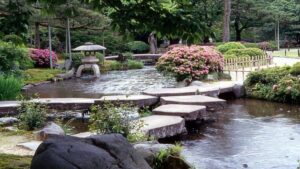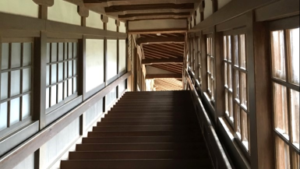Kohfukuji, 1,300 Years of Fujiwara Clan's Temple and Its Attractions
Kohfukuji Temple is the grand head temple of the Hosso sect of Buddhism. The 1,300th anniversary of Kohfukuji was celebrated with the completion of the rebuilt Chukondo Hall in 2010. The newly restored Chukondo gleamed under the blue sky, with its gold-plated Shibi on the roof being particularly striking. Colorful scattering flowers that resemble lotus petals are fluttering down. The spectacle is like a heavenly world descending to the earth. The celebration included a performance of Okina (翁), a Noh play symbolizing "beginnings" and "blessings," fitting for Kohfukuji Temple, the birthplace of the Noh play. Restoration efforts, including work on the five-story pagoda and other temple grounds, are ongoing.
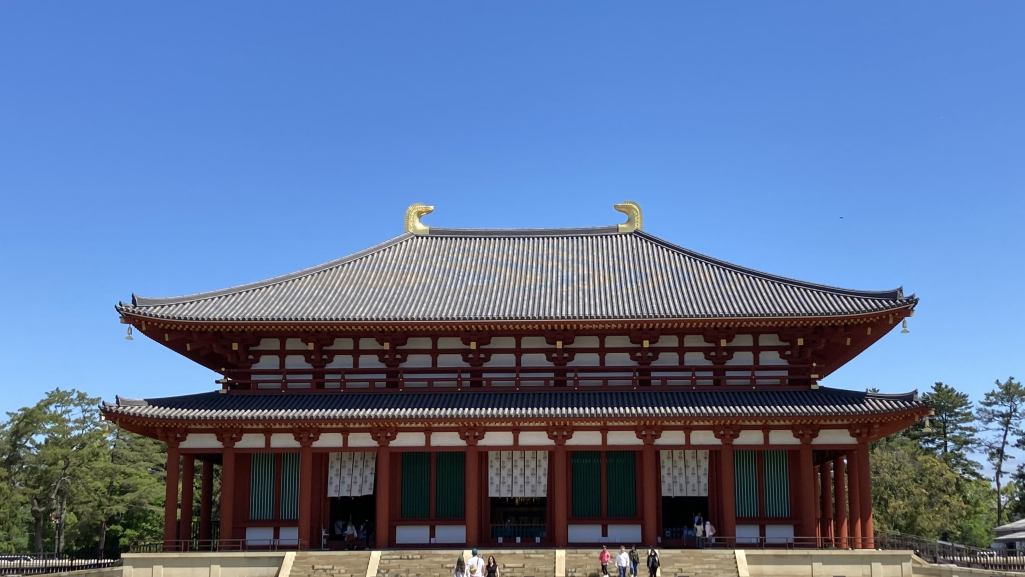
Fujiwara Kamatari and Fuhito

@The Kyoto University Museum

@LACMA
Kohfukuji is the family temple of the Fujiwara clan and was relocated to a hillside on the eastern edge of Heijo-kyo capital in 710 by Fujiwara Fuhito (藤原不比等), the minister of the right when the capital was moved there. The temple’s predecessor is believed to have been constructed to pray for the recovery of his father, Fujiwara Kamatari (?-669, 藤原鎌足), from illness. The Fujiwara clan has maintained a central role in Japanese politics for over 1,300 years, primarily due to their strategic marital relationship with the emperor.
The Great Coup D'etat Marked the Beginning of Fujiwara's Rise to Power.
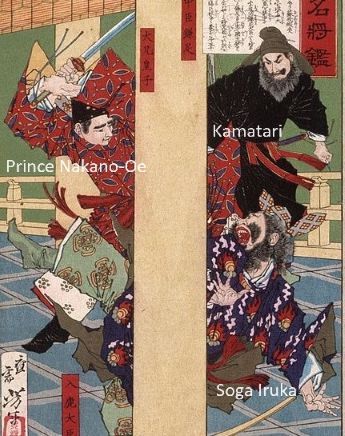
Kamatari played a crucial role in assisting Prince Nakano-Oe (626-672, later the 38th Emperor Tenji, 天智天皇) in the assassination of Soga Iruka (?-645, 蘇我入鹿), the highest authority during the reign of the 35th Emperor Kogyoku (594-661, 皇極天皇). This was the most significant coup d'état in ancient history, known as the Isshi Incident of 645.
In recognition of his contribution to these reforms, Kamatari was posthumously granted the Fujiwara surname and the highest court rank, daishokkan, by Emperor Tenji in 669. This event marked the beginning of the Fujiwara clan’s future prosperity. In 701, the first systematic legal code in Japan, the Taiho Ritsuryo, was completed with the contributions of many people, including Fuhito, Kamatari's son. This code stipulated a system in which descendants received ranks based on their fathers' ranks. Kamatari's highest court rank granted his descendants a higher social status than other clans, laying the foundation for the prosperity of the Fujiwara clan.
Expanding Power Base as a Relative of Emperors

After his political debut, Fuhito demonstrated exceptional talent, leading in ancient Japan by drafting the Taiho Ritsuryo code. In 697, Fuhito further strengthened the Fujiwara clan’s power by marrying his daughter, Miyako, to the 42nd Emperor Monmu (683-707, 文武天皇), thereby establishing himself as an external relative of the emperor. He then orchestrated the accession of his grandson, Prince Shomu, whom Miyako had borne, to the throne as the 45th Emperor Shomu (701-756, 聖武天皇). Fuhito set up his residence – now the sites of Hokkeji Temple and Kairyuoji Temple - adjacent to Crown Prince Shomu's palace, located east of Heijo-kyo palace, allowing him to monitor his grandson’s upbringing closely. From this vantage point, Kohfukuji Temple, situated on a hill, may have been visible from Shomu's Palace.
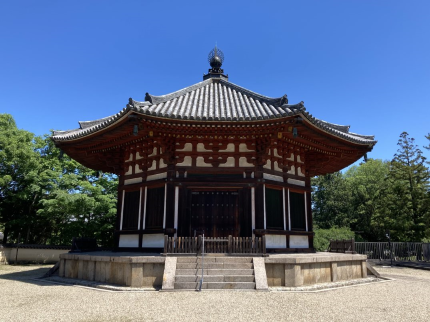
However, Fuhito died in 720, four years before Prince Shomu acceded to the throne. On the first anniversary of his death, the Hokuendo Hall was constructed to honor his spirit. This national treasure, renowned as Japan's most beautiful octagonal hall, houses a standing wooden statue of Mujaku and Seshin, who established the doctrine of the Hoso sect. This statue is considered the greatest masterpiece of Japanese portrait sculpture. Fuhito's spirit may have continued to watch over Heijo-kyo capital from the western corner of Kohfukuji Temple, the ideal location for a panoramic view of Heijo-kyo Palace.
Fujiwara Holds Power as the Maternal Relative of Emperors

When Fuhito's sons became high court officials in 730, four out of ten high court officials were members of the Fujiwara clan. By around 1010, the Fujiwara had nearly monopolized these positions. During the middle of the Heian period (11C), Fujiwara Michinaga (966-1028,藤原道長) solidified the clan’s dominance by arranging the marriage of his daughter, Shoshi (988-1074, 彰子), to the 66th Emperor Ichijo (980-1011, 一条天皇), making him the maternal grandfather of Emperors Sanjo (976-1017, 三条天皇) and Go-Ichijo (1008-1036, 後一条天皇). This strategic marriage established the pinnacle of Fujiwara's power. Though it sometimes waned, the Fujiwara clan maintained political influence until the 20th century. The clan’s power stemmed from their ability to influence the emperor, who had the final say in political matters. Princes born to Fujiwara mothers were raised within their maternal families, allowing the Fujiwara, the maternal grandfather, to exert significant influence over future emperors from an early age.
National Treasure Trove
Kohfukuji Temple is a treasure trove of over 30 National Treasures, including the majestic Chukondo Hall, the five-story pagoda, as the influential Fujiwara clan who had stood at the center of power for over 1,300 years. Don't miss out on exploring the beginning of the Fujiwara clan's prosperity starting with Kamatari and Fuhito. Also, visit the Hokuendo Hall to reflect on Fujiwara Kamatari, Fuhito, and the subsequent Fujiwara clans that laid the foundation for the Heijo-kyo capital and Japan, contributing to its prosperity and glory for over 1,300 years. Kofuku-ji Temple continued to thrive with the Kasugataisha shrine, the Fujiwara family shrine.
Fujiwara Kamatari & Fuhito Timeline
| Kamatari | Fuhito | E.Tenji | E.Shomu | Period | ||
|---|---|---|---|---|---|---|
| 614 | Nakatomi (Fujiwara) Kamatari was born | 1 | Asuka | |||
| 626 | Prince Nakano-Oe was born | 13 | 1 | |||
| 642 | Empress Kogyoku ascended to the throne | 31 | 19 | |||
| 645 | First conflict of the Goguryeo–Tang War | 34 | 22 | |||
| 645 | Soga Iruka was assassinated by Prince Naka-no-Ōe (Isshi Incident) | 34 | 22 | |||
| 645 | Empress Kogyoku abdicated while still alive to her brother, Emperor Kotoku | 34 | 22 | |||
| 645 | Prince Furuhito, the next emperor's candidate, was assasinated | 34 | 22 | |||
| 647 | Seconf conflict of the Goguryeo–Tang War | 36 | 24 | |||
| 659 | Fujiwara Fuhito was born | 47 | 1 | 36 | ||
| 668 | Emperor Tenji (Prince Nakano-Oe) ascended the throne | 56 | 10 | 45 | ||
| 669 | Kamatari passed away and given Fujiwara name | 57 | 11 | 46 | ||
| 672 | Emperor Tenji passed away | 14 | 49 | |||
| 697 | Emperor Monmu ascended the throne with the support of Fuhito | - | 39 | - | ||
| 701 | Taiho Code was completed | - | 43 | - | ||
| 701 | Emperor Shomu was born | - | 43 | - | 1 | |
| 710 | Relocation of the capital to Heijo-kyo in Nara from Asuka | - | 52 | - | 10 | Nara |
| 710 | Relocation of Kohfukuji to Nara | - | 52 | - | 10 | |
| 720 | Fujiwara Fuuhito Passed away | - | 62 | - | 20 | |
| 724 | Emperor Shomu ascended to the throne | - | - | - | 24 | |
| 729 | Nagayao incident occurred | - | - | - | 29 | |
| 730 | Fujiwara four brothers became high court officials | - | - | - | 30 | |
| 737 | Fujiwara four brothers died of smallpox | - | - | - | 37 | |
| 743 | Todaiji Great Buddha construction started till 752 | - | - | - | 43 | |
| 749 | Emperor Shomu abdicated from the throne and was ordained | - | - | - | 49 | |
| 752 | Todaiji Great Buddha, eye-opening | - | - | - | 52 |
Recommendations to Visit
Kohfukuji Temple
- Access: A 5-minute walk from Kintetsu Nara Station. Or 5 minutes by the City Loop Bus (No. 2) and get off at the “Kenchōmae” bus stop.
Heijo-Kyo Palace
- Access: A 10-minute walk from the South Exit of Kintetsu Yamato-Saidaiji Station, or A 13-minute walk from Kintetsu Nara Station.

